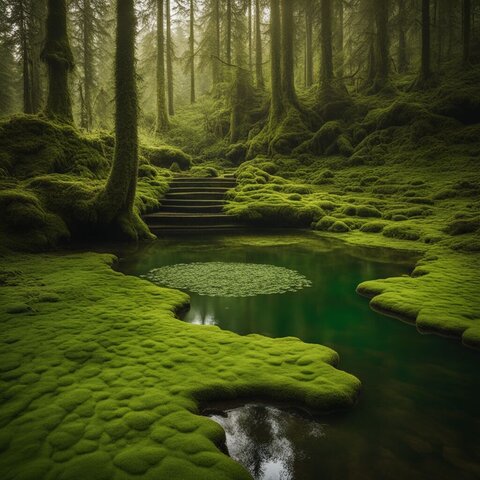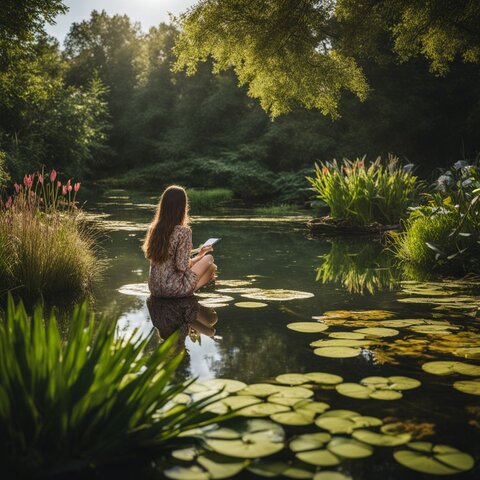
How To Get Rid Of Moss In A Pond
Explore how to get rid of moss in a pond and rejuvenate your water feature's natural beauty.
Moss can overtake ponds if left unchecked, disrupting the aquatic ecosystem.
Our guide offers safe and simple strategies to clear your water haven of unwanted moss growth without harming its natural beauty.
Dive in for crystal-clear solutions.
Understanding Moss Growth in Ponds
Algae growth, often referred to as pond scum, can transform a clear pond into a green blanket, potentially harming plant and aquatic life.

It often starts when the water has too many nutrients like nitrogen and phosphorus.
These often come from fertilizers used on lawns and gardens nearby. When it rains, the runoff water carries these nutrients into ponds.
Sunlight, along with factors like water temperature and stagnation, contributes to the rapid spread of algae across your pond's surface.
Warm weather exacerbates algae growth by accelerating its rate of spread, making pond management more challenging.
Blocking sunlight to the pond can slow down this process but it's not always enough to fix the problem on its own.
You must control the nutrients at their source by checking what feeds into your pond waters.
Safe and Effective Tips to Eliminate Moss
Discover practical strategies for getting rid of pond moss effectively, without harming the delicate balance of your aquatic ecosystem.

Dive into hands-on techniques and natural solutions that will help you maintain a clear and healthy pond environment.
Using a Scoop or Vacuum
Get rid of pond moss off the water's surface with a scoop. This simple tool lets you grab big chunks of moss and pull them out easily.
For the moss at the bottom, grab a pond vacuum. Pond vacuums work great for getting rid of algae that settles deep down.
They suck up unwanted plants and make your pond look clear.
Next up, adding algae eaters can help keep new growth under control.
Introducing Algae Eaters
Algae eaters are your pond's natural cleaners.
While Goldfish and Koi may occasionally graze on algae, relying solely on them for algae control is not effective.
It's crucial to combine biological, chemical, and mechanical methods for comprehensive pond management.
Tadpoles gobble up algae as they grow into frogs. Plecos, also known as suckerfish, stick to the sides of your pond and scrub away unwanted growths.
Adding these creatures turns a problem area into a lively habitat.
They help maintain balance by eating plant matter before it decomposes and adds to nutrient levels.
With fish and tadpoles at work, you'll notice clearer water and less moss over time.
Plus, they make great additions that bring life and movement to your backyard oasis!
Utilizing Nutrient-Absorbing Plants
Put watercress, lily pads, and cattails in your pond to fight moss. These plants take up extra nutrients that moss needs to grow.
They also add beauty to your pond. As they thrive, these natural helpers cut down on the food supply for moss.
Choose these green warriors as a safe way to keep algae and moss under control.
They work well without harming fish or the environment. Your pond stays clean and looks great too!
Adding Beneficial Bacteria
After planting nutrient-absorbing plants, take another step toward getting rid of pond moss by adding beneficial bacteria.
These helpful microbes work to balance your pond's ecosystem. They break down extra nutrients and organic matter, which moss and algae love to eat.
Without this food, moss can't grow as much.
Adding beneficial bacteria can be a safe way to improve water quality, provided the conditions support their growth and activity.
These conditions include adequate oxygen levels and appropriate water temperatures.
With regular use, these bacteria keep the pond clean and prevent toxic algae blooms that harm life in the water.
Your pond stays balanced with clear, quality water that supports a diverse range of life without letting moss take over.
Employing a Zeolite Stone
Zeolite stones are a natural choice to get rid of moss in your pond. They absorb nitrates from the water which can feed algae growth.
Placing zeolite stones in your pond can help absorb nitrates, but their effectiveness depends on the pond's size, nutrient levels, and other management practices in place.
It pulls excess nutrients out of the water, leaving less food for moss to thrive.
Using zeolite is safe for plants and fish too! These stones create cleaner conditions by managing nutrient levels.
You won't need harsh chemicals or complicated equipment with these around.
Don't forget to replace or recharge them as needed so they keep doing their job well.
Installing a Filter
Installing a filter can be a game-changer for your pond's health. It pulls out extra nutrients that feed moss and clears the water of debris.
This makes it hard for moss to grow. A good filtration system also improves the overall quality of pond water, which is great for fish and plants.
Make sure you set up your filter correctly and keep it clean. Change the media as needed to keep it working well.
Doing this stops moss from coming back and keeps your pond clear. Filters are safe for wildlife and don't harm your pond friends.
To stop moss from growing again, we need to look at how we can improve water circulation in the pond.
Preventing Moss Reinfestation

To keep your pond pristine and moss-free, adopting proactive strategies can safeguard against future growth, ensuring the health and beauty of your aquatic haven.
Improving Water Circulation
Good water movement is key in fighting moss in your pond. It keeps the water fresh and stops moss from taking over.
Balancing Nutrient Levels
Moss thrives in ponds with too many nutrients. Control the nutrient levels to keep moss away.
- Test your pond water to check for excess nutrients. Kits are available at garden stores.
- Cut back on feeding fish. Excess fish food can decay and boost nutrient levels.
- Place nutrient - absorbing plants in the pond. They suck up extra nutrients and starve the moss.
- Avoid using fertilizers near your pond. Runoff from lawns can increase nutrients in the water.
- Clean pond waste regularly. Decaying leaves and dead algae add to nutrient buildup.
- Use barley straw in your pond. As it decomposes, it helps control algae growth without harming fish.
- Make sure soils around your pond aren't compacted. Compacted soil can lead to more runoff into your pond.
- Plant turfgrass or other plants around the pond edge. They absorb runoff before it reaches the water.
- Don't forget aerating your pond. It helps break down excess nutrients faster.
Regular Pond Maintenance
Regular pond maintenance is key to keeping moss away. A well-kept pond discourages unwanted growth and maintains a healthy environment. Here are some steps you can take:
- Skim the water surface often with a scoop to remove any moss.
- Clean the bottom of your pond with a vacuum to get rid of algae and debris.
- Trim trees around the pond to limit shade; too much shade boosts moss growth.
- Feed your fish only what they can eat in five minutes to avoid overfeeding.
- Check and adjust the pH level of the water regularly for optimal balance.
- Replace at least 10% of the pond water each week to keep it fresh.
- Inspect your pond plants, removing dead leaves and stems that decompose and feed algae.
- Use barley straw as it decomposes because it releases chemicals that fight algae without hurting other plants or animals.
- Consider adding dye to the water. It blocks sunlight, which helps stop weeds from growing.
- Make sure all equipment, like pumps and filters, works properly by checking them frequently.
FAQs
Can I use herbicides to remove moss from my pond?
While specific herbicides are available for pond algae control, their use requires careful consideration of the potential impact on fish, plants, and the overall ecosystem. Always follow label instructions and consider non-chemical alternatives first. It's important to consult professionals or conduct thorough research before application could be useful.
Will dyed water help keep the moss away in a pond?
Dyeing your pond water can block sunlight, which can help prevent moss growth. Make sure the dye is safe for fish and plants before using it.
Can fertilizing my lawn cause more moss to grow in my pond?
Fertilization near the pond may run off into the water and encourage more moss to grow because of extra nutrients that algae feed on.
Has there been a big problem with fish kills when treating ponds for moss?
In some places like Grand Lake St. Marys, incorrect treatment of ponds has resulted in large-scale fish kills; carefully select treatments that are safe for aquatic life.

Conclusion
Keep your pond clean and clear by using these natural methods to remove moss.
Remember that the key is in prevention, so focus on keeping nutrients balanced and water well-circulated.
Before implementing these strategies, assess your pond's unique conditions, including water quality, sunlight exposure, and existing aquatic life, to choose the most effective and safe methods for your situation.
Friendly fish and plants can lend a helping hand in fighting off unwanted algae.
Trust in these safe tips for a beautiful, moss-free pond environment. Your aquatic sanctuary awaits!

